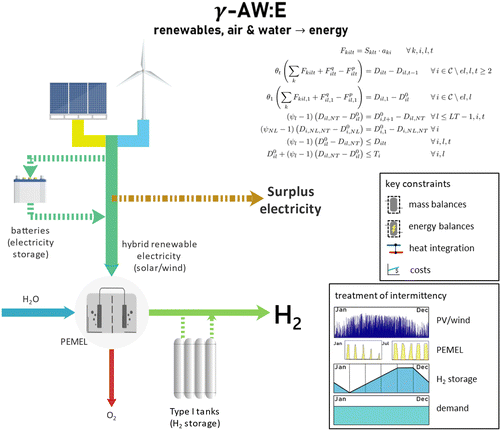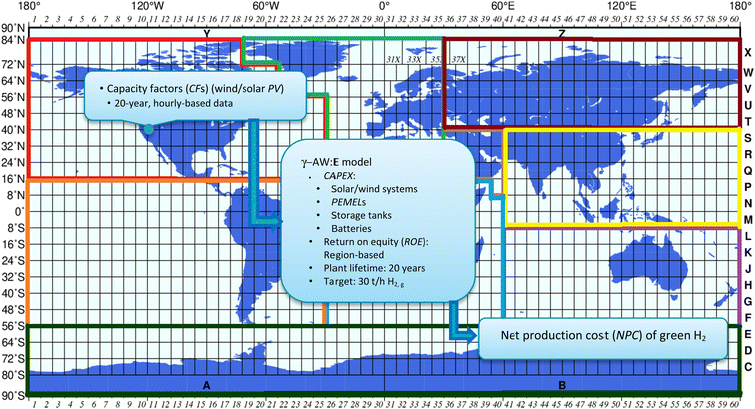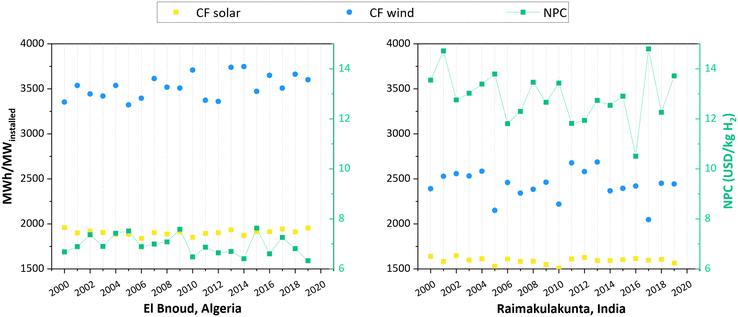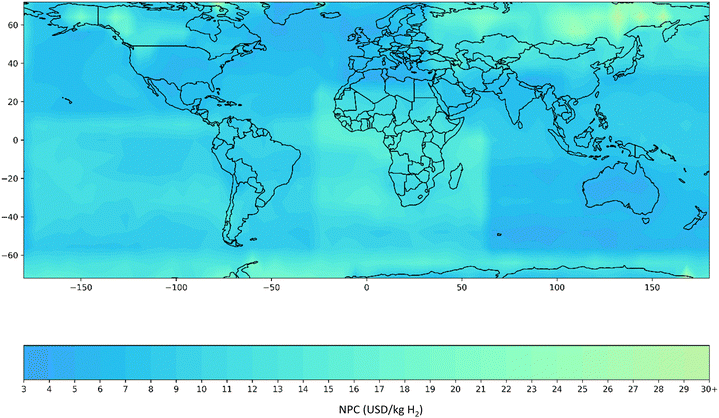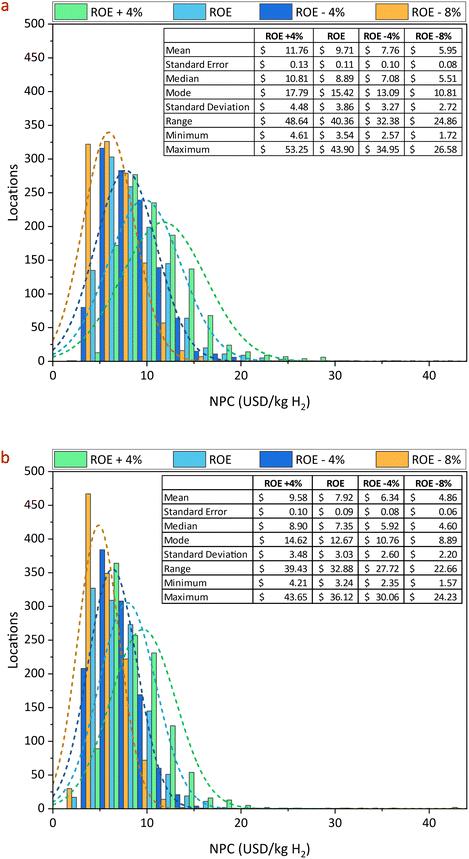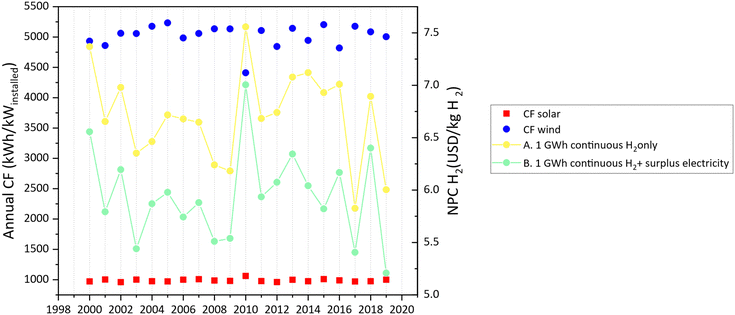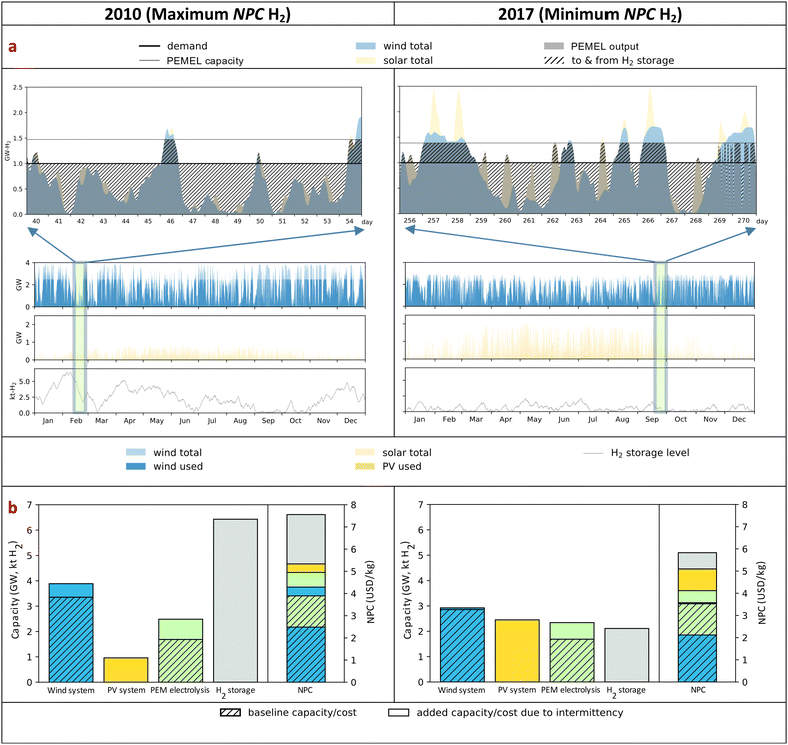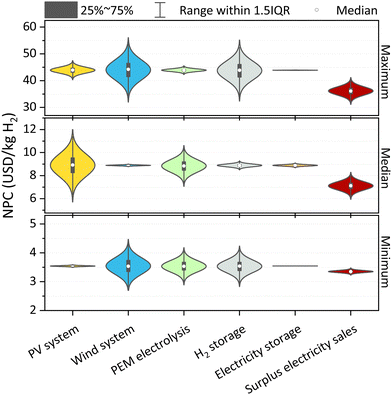 Open Access Article
Open Access ArticleCreative Commons Attribution 3.0 Unported Licence
Quantifying global costs of reliable green hydrogen†
D.
Freire Ordóñez
 ab,
C.
Ganzer
ab,
C.
Ganzer
 ad,
T.
Halfdanarson
d,
A.
González Garay
ad,
T.
Halfdanarson
d,
A.
González Garay
 a,
P.
Patrizio
d,
A.
Bardow
a,
P.
Patrizio
d,
A.
Bardow
 c,
G.
Guillén-Gosálbez
c,
G.
Guillén-Gosálbez
 e,
N.
Shah
a and
N.
Mac Dowell
*ad
e,
N.
Shah
a and
N.
Mac Dowell
*ad
aThe Sargent Centre for Process Systems Engineering, Imperial College London, UK. E-mail: niall@imperial.ac.uk
bInstitute for Applied Sustainability Research, Quito, Ecuador
cEnergy and Process Systems Engineering, Department of Mechanical and Process Engineering, ETH Zürich, Switzerland
dCentre for Environmental Policy, Imperial College London, UK
eInstitute for Chemical and Bioengineering, Department of Chemistry and Applied Biosciences, ETH Zürich, Switzerland
First published on 16th October 2023
Abstract
The current energy crisis has resulted in natural gas prices at an unprecedented level in many parts of the world, with significant consequences for the price of food and fertiliser. In this context, and with the projected reduction in the costs of renewables and electrolysers, green hydrogen is becoming an increasingly attractive option. In this study, we evaluate the current and future costs of green hydrogen, produced on a reliable schedule, so as to be coherent with industrial demand. Here, we take full account of both inter- and intra-annual variability of renewable energy, using 20 years of hourly resolution wind and solar data from 1140 grid points around the world. We observe that simply using average annual capacity factors will result in a significantly under-sized system that will frequently be unable to meet demand. In order to ensure production targets are met, over-capacity of power generation assets and energy storage assets are required to compensate for inter-annual and intra-annual variations in the availability of wind and solar resources, especially in the time periods known as “dunkelflauten”. Whilst costs vary substantially around the world, contemporary costs of reliable green hydrogen are estimated to be, on average, 18–22 USD per kgH2 with a minimum of 5 USD per kgH2, depending on the ability to monetise “surplus” or “excess” renewable energy. The primary cost driver is renewable energy capacity, with electrolysers and energy storage costs exerting a second-order effect. With cost reduction, future costs are anticipated to be, on average, 8–10 USD per kgH2 with a minimum of 3 USD per kgH2, again as a function of the ability to monetise otherwise curtailed power. Another key factor in future costs is found to be hurdle rates for capital investments. Finally, we observe that continued cost reduction of renewable power is key to reducing overall system costs of green hydrogen production.
1. Introduction
Recent geopolitical events have led to a renewed focus on energy security. In some regions, this fact has led to increased attention to the value of modern renewable energy in general, and that of green, or electrolytic, H2 in particular.As has been discussed elsewhere,1–6 for electrolytic H2 to be considered truly low-carbon, the power supply must be abundant, cheap, and deeply decarbonised, with a carbon intensity in the range of 30–70 kgCO2 MWh−1. At the time of writing, this is not available in most regions via a grid connection, and thus, in order to meet ambitious targets for production,7–12 new power generation assets will be required.
Recently, some very ambitious targets for the low cost production of green hydrogen (H2,g), i.e., hydrogen produced exclusively via renewable power, have been articulated, with stated goals of achieving prices of 1 USD per kgH2,g13,14 Whilst wind and solar power are becoming increasingly cheap, their intermittency will inevitably present cost challenges in the form of decreased capital asset utilisation. This is due to the oversizing of the production and storage units required to balance the effect of the inter-daily, inter-seasonal and inter-annual variability that characterise wind and solar energy resources. Thus, a production facility will need access to sufficient power generation and energy storage capacity – either electrons or protons so as to reliably produce green H2. Moreover, H2 orders will need to be filled on time, and, increasingly, to a defined carbon intensity – simply relying on the grid as a backup may not be an option. As a given production facility will be expected to operate for 15–25 years, all these factors must be taken into account in its design and in assessing the costs of producing reliable green H2.
Importantly, such an energy supply from renewable sources would have the virtue of being entirely insulated from the volatility of the fossil energy markets. The question is, at what cost can a reliable supply of green H2 be obtained, and under what circumstances, if any, can the goal of 1 USD per H2,g be reached?
A brief history of hydrogen
In the context of green H2, it is important to recognise that its production has a long history, with the first laboratory demonstration taking place in 178915 by the Dutch merchants Jan Rudolph Deiman and Adriaan Paets van Troostwijk. It took about a century for this concept to be demonstrated in an industrial context; in 1888, the Russian engineer Dmitry Lachinov16 demonstrated the industrial production of hydrogen and oxygen, and by 1902, more than 400 alkaline water electrolysis (AE) units were in operation,22 and this technology persists until this day. By the 1920's, the technology had been brought to the 100 MW scale, primarily for the production of ammonia fertiliser in Canada and Norway using low-cost hydroelectricity.23 Technology innovation has continued, and Thomas Grubb and Leonard Niedrach developed the polymer electrolyte membrane (PEM) electrolysis technology at General Electric Co. in the early 1960s.24–26 This technology has significant advantages compared to alkaline electrolysis, namely higher energy efficiency and product purity, lower maintenance costs and a wider operating range in terms of current density and pressure, which allows a quick reaction to fluctuations typical of renewable energy generation.24,27–29Over the past 60 years, technology for producing green H2 has continued to improve. In 1972, the development of water electrolysis with solid oxides began, while advanced alkaline systems started to be developed from 1978 onwards.22 By 1985 in Germany, Dönitz and Erdle published the first results for solid oxide electrolyser cells (SOEC) based on electrolyte-supported tubular cells as part of the HotElly project.30 In spite of the progress in PEM and SOEC electrolysis, they were not commercialised on a large scale at that time, mainly because of their high cost. It is since the 1990s, and especially in the last ten years, that water electrolysis has gained significant interest worldwide, as green H2 has become valued as a carrier of renewable energy, and for powering fuel cells.31
At present, the commercial maturity of these electrolysis technologies varies, with alkaline electrolysers (AELs) being the most mature technology, followed by proton exchange membrane electrolysers (PEMELs) and solid oxide electrolyser cells (SOECs), the latter being still in the demonstration phase.32
Despite the long history of technical innovation on the supply side, growth on the H2 demand side has been historically sclerotic for a variety of technical, economic, and policy reasons. In 2020, global hydrogen demand was approximately 90 Mt. This has grown from 35.3 Mt in 1990 – a rate of about 1.8% per year.33,34
The role of hydrogen in net zero targets
As nations come forward with net-zero strategies to align with their international climate targets, hydrogen has once again risen up the agenda from Australia and the UK through to Germany and Japan.35 Its use is now being seriously considered by different sectors, e.g., heat, power, mobility, and industry.36 As a full-scale H2 economy develops, the global demand for H2 is expected to increase from ≈95 Mt per year today to ≈650 Mt per year by 2050.37 In the case of green H2, the European Union has announced its ambitions to produce 1 Mt for the 2020–2024 period with the aim to reach 10 Mt per year for the period between 2025 and 2030.38In the wake of renewed interest in green H2, driven by the current global situation where access to low-cost money, global supply chains, and cheap energy is becoming increasingly difficult, several studies have reported various cost figures, both current and future, as shown in Table 1. As can be observed, reported costs for green H2 are in the range of 1.6–9.8 USD per kgH2,g. In most cases, the low-cost estimates rest upon optimistic techno-economic assumptions, e.g., low-interest rates or rapid technological improvements of electrolytic processes. In other cases, studies have envisaged excess renewable energy being abundantly available at zero cost, for H2O electrolysis. In addition, some of the figures reported have been calculated on the basis of fixed interest rates, regardless of the production location, which does not reflect the investment risk associated with the different regions of the world, and could introduce substantial bias to the results.39,40 Furthermore, most of these studies do not clearly explain how the intermittency of renewables is accounted for in the calculation of the reported costs, which is a crucial factor given the need to ensure continuous production of green H2.
| Source | Reported cost | Assumptions |
|---|---|---|
| Bertuccioli et al. (2014)17 | 5.9–8.7 USD per kgH2,g in 2012 and 4.2–6.7 USD per kgH2,g in 2030 | – Trend lines constructed through stakeholder consultation |
| – PEMEL costs between 2690–3355 USD per kW in 2012 and 361–1836 USD per kW by 2030 (figures account for capital costs of key components of the electrolysis technology but exclude installation expenses, e.g., civil works, land use and additional project costs). | ||
| – Electricity price: 72 and 115 USD per kW per h for the low and high values, respectively. | ||
| – Full-load operation | ||
| Felgenhauer and Hamacher (2015)18 | 5.5–9.8 USD per kgH2,g | – PEM electrolysis process driven by low-cost electricity (78–81 USD per MW per h) |
| – Full-load operation. | ||
| IEA (2019)12 | Long-term global costs ranging from less than 1.6 to more than 4.0 USD per kgH2,g. | – Green H2 produced from hybrid solar PV and onshore wind systems |
| – Fixed discount rate: 8% | ||
| – CAPEX: | ||
| – Electrolyser: 450 USD kWe−1 (efficiencyLHV: 74%) | ||
| – Solar PV system: 400–1000 USD per kW | ||
| – Onshore wind system: 900–2500 USD per kW | ||
| Hydrogen council (2020)19 | 6.0 USD per kgH2,g for 2020, falling to 2.6 USD per kgH2,g by 2030. | – PEMEL operating at a capacity factor (CF) of 0.5 with an electricity supply from both solar and wind power. |
| – Constant learning rates of 13% for the PEMEL | ||
| – Installed capacity of electrolysers in 2030:90 GW | ||
| – Electricity costs: down from 57 to 33 USD per MW per h. | ||
| Mallapragada et al. (2020)20 | 2.5 USD per kgH2,g or less by 2030, depending on the system's configuration and location. | – Levelised cost for a continuous supply of green H2 from PV-electrolysis by 2030 based on the least-cost modelling of design and operations. |
| – Cost projections rely on a sharp reduction in the cost of PV systems (42%), PEMELs (62%) and H2 storage vessels (33%), as well as an increase in electrolyser efficiency (+12% on a lower heating value (LHV) basis) compared to current values (2020). | ||
| IRENA (2020)21 | Current production cost: 2.7–6.0 USD per kgH2,g | Present: |
| – Electricity cost: 53 USD per MW per h | ||
| – Electrolyser efficiencyLHV: 65% | ||
| – Lifetime of electrolyser: 10 years | ||
| – Full load hours: 3200 (onshore wind) | ||
| – Weighted average cost of capital (WACC): 10% | ||
| Future cost projections: 0.8–1.2 USD per kgH2,g | Future: | |
| – 80% reduction in electrolyser costs | ||
| – Electricity cost: 20 USD per MW per h | ||
| – Electrolyser efficiencyLHV: 76% | ||
| – Lifetime of electrolyser: 20 years | ||
| – Full load hours: 4200 (onshore wind) | ||
| – Weighted average cost of capital (WACC): 6% |
2. γ-AW:E model for green hydrogen
Most studies assessing the production of platform chemicals and fuels from renewable energies assume that renewable electricity is available at a fixed cost, often based on an average of different studies.41 However, in reality, the cost of electricity will be a location-dependant function of the inter- and intra-annual variability of renewable energy at that specific point in the globe. It will further be key to “right-size” the installed capacity of both power generation and energy storage assets so as to overcome inter- and intra-annual variability in availability. It will further be important to account for the regional variation in the hurdle rate, i.e., return on equity (ROE), associated with a given capital project and account for how this impacts project costs.42,43Thus, this study employs a modified version of the γ-AW:E model43 to assess the continuous production of green H2 from a hybrid solar and wind energy system at any particular location. This model quantifies the capacities of the processes (solar PV, wind, PEMEL) and energy storage (H2 or electricity) units, including the additional capacity needed to balance the inter- and intra-annual intermittency of renewables. It is therefore possible to estimate the amount of surplus electricity, i.e., the excess electricity generated as a result of oversizing the process units, which can be sold, thus contributing to lowering the cost of green H2 production. The model is illustrated in Fig. 1.
In essence, the model follows the principles of reaction network flux analysis.44 The inputs are the chemical compounds involved, reaction pathways available, storage options, mass and energy balances (including heat integration), CAPEX of the equipment units and the location-specific availability of renewable energy. From this information, the model determines the cost-optimal production route, including the plant's optimal design and operation required to meet the production target. Further details on this model initially designed to evaluate optimal production routes of solar ammonia and methanol, including all equations and assumptions, are available in the original publication.43
3. Study framework and scenario description
In this contribution, we quantified the net production cost (NPC) of green H2 for a plant with a production target of 1 GWLHV, i.e., 30 t h−1 H2,g. Based on this target, ≈ 335 and 2500 of these production plants would be needed to meet the current and future global demand for H2, respectively.45–47 This NPC was calculated for 1140 locations, derived from the Universal Transverse Mercator (UTM) coordinate system and grouped in nine global regions based on the capital cost values of wind and solar energy provided by the IEA's World Energy Outlook48 and IRENA.49 The worldwide production cost of green H2 was assessed for 2019 (today) and 2050 (future). Fig. 2 shows the system's framework adopted in this study.To capture the risk associated with hydrogen investments in different regions of the world, we adopted a region-specific ROE (see ESI,† Appendix B), i.e., the profit margin required for an investment or project to proceed.50 For offshore projects, located within one grid cell from land, we took the onshore ROE + 1.5% for 2019. As cheaper and less risky offshore projects are expected in the future, it was assumed that the onshore and offshore ROE will be the same in 2050. We considered for deep offshore locations, i.e., those beyond one grid cell from land, the offshore ROE + 3%, both for 2019 and 2050.51,52 In addition, to accurately account for the seasonal and daily intermittency of wind and solar power, we worked with 20 years hourly CFs (from 2000 to 2019) for each location.53,54 To identify realistic cost projections of PEMELs, we followed a bottom-up approach and decomposed their manufacturing into a range of sub-processes, from which the potential cost reduction was quantified by applying learning rates (see ESI,† Appendix A.1.). The present and future NPC of green H2 at each location and for each of the 20 years was then calculated according to the procedure detailed in Appendix A.2. from the ESI,† provided in Appendix B.
Since a surplus of electricity can be generated due to the production of a fixed flow of green H2, the cost of production at each location was further assessed on the basis of two scenarios, namely, (i) when revenues from the sale of the surplus electricity are excluded from the maximum NPC obtained from the 20 years analysis (Scenario 1), and, (ii) when these revenues are included in the minimum NPC obtained from the 20 years analysis (Scenario 2). It was assumed that the surplus electricity could be sold at the levelised cost of production (see ESI,† Appendix A.2.). In this way, the value of connecting the system to the grid was evaluated based on site-specific factors.
4. The impact of intra-annual variability of renewable energy
A critical yet often overlooked aspect associated with the production of H2 is the intermittent nature of renewable energy sources (RES),42,43 whose availability depends on local conditions at any given time.55,56 To balance interannual, seasonal, and daily fluctuations in renewable energy and enable the reliable production of green H2, it is essential to have both sufficient capacity of both energy storage and power generation, as well as capacity of electrolysis units. Neglecting to do this will result in an under-sized system which will be frequently unable to meet demand over its economic lifetime.Therefore, an accurate assessment of the cost of green H2 requires assessing the seasonal and daily fluctuation of renewable energy with sufficient spatial and temporal resolution. In this area, a conventional approach in energy system modelling is to represent each year by sequences of days (representative days) instead of using full hourly data by following different approaches such as heuristics, clustering, random selection, optimisation models, and structured algorithms, depending on the application.57–61 However, it has been shown that the solution to this type of problem can be more reliable and accurate when a full hourly resolution is used, as seasonal changes in the availability of renewables are represented in greater detail.62 Thus, as long as model solution times are within an acceptable range, a more detailed representation of time should be used to ensure more robust results.
The results presented in Fig. 3 illustrate this point. As can be observed, owing to the interannual variation in the availability of renewable energy (represented by the CFs of wind and solar power) – primarily wind power, the NPC of green H2 varies by between 21–41% over the 20 years analysis.
The remainder of this paper is set out as follows; we first present the results of the current and future production cost of green H2 in maps, along with a statistical analysis of their cost distribution, including and excluding the potential sale of surplus electricity. Next, the results of a detailed analysis of the cost of intermittency are presented and discussed. Finally, the results of sensitivity and risk analyses of future green H2 production costs are reported, in which the impact of variations in the projected capital cost and system components are assessed.
5. Hydrogen net production costs (NPC): present and future
The maximum NPCs resulting from the 20 years analysis at each location are plotted in the maps in Fig. 4 and 6 for “today” and the “future”, respectively. Furthermore, the distribution of costs and results of the statistical analyses are presented in Fig. 5 and 7, for “today” and the “future”, respectively. The present production cost of green H2 ranges from 5–72 USD per kgH2,g, with an average of 22 USD per kgH2,g and a median of 21 USD per kgH2,g. This can be reduced to 5–63 USD per kgH2,g, with an average of 18 USD per kgH2,g and a median of 17 USD per kgH2,g, when revenues from the sale of surplus electricity are considered. | ||
| Fig. 4 NPC of green H2 “today”. The map illustrates the variation of the maximum global NPC of green H2 with existing technologies. | ||
As shown in Fig. 7, the average cost of green H2 in the future is anticipated to be approximately 56–57% lower than the current cost, primarily owing to the projected cost reduction of renewable energy (see Fig. C-3 in the ESI†). Cost reductions and efficiency improvements in energy storage technologies and PEMELs21,63 lead to further cost reductions. As a result, costs in the range of 3–36 USD per kgH2,g and 3–44 USD per kgH2,g, with an average of 8–10 USD per kgH2,g, are obtained for the scenarios including and excluding the potential savings of selling excess power, respectively.
As can be observed, there is a considerable decrease in average overall costs due to the sale of surplus power to the electricity system. This has implications as to the kinds of contracts that may be entered into between the electrolysis facility and the renewable power producers, e.g., a power purchase agreement with the provision to sell surplus power to the grid. This highlights the importance of ensuring that grid infrastructure has the facility to incorporate renewable power that would otherwise be curtailed. In this context, the installation of regional grids could contribute not only to alleviating this additional burden on national power systems by absorbing part of it but also to reducing the cost associated with increasing their capacity.64
From a geographic standpoint (see Appendix C in the ESI†), the cheapest green H2 would be produced in Greenland at present (from electrolysis powered by approximately 50% solar electricity and 50% wind electricity) and in the future (from electrolysis powered almost exclusively by wind electricity). Overall, when we compare the best possible locations in the future with respect to the present in terms of the cheapest NPC of green H2, we see a shift from onshore to offshore locations, owing to higher CFs in power generation and a greater rate of reduction in the cost of offshore wind relative to other options.
As can be observed from Fig. 4 and 6, the anticipated “current” and “future” cost of hydrogen production varies substantially around the world. Costs are observed to be driven by myriad factors, including availability of land and water, distance from market, and the cost and reliability of the energy supply. A detailed analysis of these cost breakdowns is presented in Appendix C.
The breakdown of current and future green H2 NPC for the best production locations (see Fig. C-3 in the ESI†) reveals that renewable energy systems account for approximately 50% of the cost. PEM electrolysis and energy storage systems each account for approximately 25% of the cost. Conversely, for the locations with the greatest level of inter- and intrannual intermittency, 50% of the cost is associated with energy storage systems. This is discussed in more detail in the next section as “the cost of intermittency”.
Through a variety of policy mechanisms, e.g., contracts for difference, strike prices, production mandates/obligations, tax credits, etc., it is possible to significantly reduce the capital risk associated with the deployment of new technologies. Thus, a sensitivity analysis is performed on the required ROE, or hurdle rate, to analyse its influence on the future NPC of green H2. For this purpose, we vary the ROE according to three scenarios, namely, (i) ROE – 8%, (ii) ROE – 4%, (iii) ROE + 4%.
As shown in Fig. 7, reducing the ROE by 4% would represent a decrease of approximately 20% relative to the reference case, with an equivalent increase in ROE having an equivalent, opposite effect. It was observed that only if the ROE was reduced by 8% compared to the reference value, would the NPC be decreased such that green H2 could be produced for less than 2 USD per kgH2,g (1.6 USD per kgH2,g, to be precise). Such a decrease in ROE would represent a fairly low cost of capital, as in the case of Europe, where the ROE for onshore wind would be 1.6%. Given the current outlook for central bank interest rates,65 this seems to be a very ambitious assumption.
6. Green hydrogen: the cost of intermittency
Subsequent analysis was performed to quantify the impact of intermittency on the cost of hydrogen. For this purpose, the Isle of Jura in the UK was chosen as a reference for this analysis due to the high inter- and intra-annual intermittency of the wind energy available there (represented by the wind CFs in Fig. 8 and 9(a)). Fig. 8 also illustrates the annual NPC of green H2 from 2000 to 2019. As can be observed, owing to the inter- and intra-annual variation of the wind, there is a 35% variation in the NPC over this 20 years period.The cost of intermittency is defined as the difference in system cost between the optimal system with the actual wind/solar profiles and a hypothetical baseline system, i.e., a steady-state plant operating at constant availability (equivalent to the 20 years average CF) that produces a constant supply of green H243 In our case, the baseline cost was calculated assuming all wind CF in the reference year was used to produce H2. Further details on the calculation procedure, including the equations used, can be found in Appendix A.3.
Fig. 9(a) contrasts the CFs, system design and operation of the years with the highest (2010) and lowest (2017) NPC. Owing to both inter- and intra-annual variations in CFs, it is necessary to install H2 storage capacity and oversize production units to satisfy demand during periods of low availability of renewables. As illustrated, the electrolyser is oversized and operated at full capacity when renewable energy is available, feeding green H2 to storage. In turn, stored H2 is used to meet demand during periods of low availability of renewable energy. This variable optimal operation of the electrolyser emphasises the value of electrolysers being able to operate flexibly.
The time periods shown in Fig. 9(a) represent potential bottleneck periods for the system, i.e., multiday periods when CFs are low (also known as “dunkelflaute” or “dark doldrums”), which could determine the system design. It is evident that the potential bottleneck period in 2010 exhibits more extended periods of lower CFs than in 2017, leading to the difference in system design and the corresponding cost.
As illustrated in Fig. 9(b), the cost of intermittency accounts for approximately 49% and 41% of the total NPC of green H2 in 2010 and 2017, respectively. As can be seen, more generation and storage capacity is needed in 2010 to compensate for the periods of low CF.
7. Future costs of green hydrogen: sensitivity and risk analysis
Here, Monte Carlo simulations are carried out to study the impact that the variation in the cost of each component of the H2,g system would have on its future NPC. To this aim, 1000 independent samples from the minimum, median and maximum NPC values were evaluated. We assumed a normal distribution with an SD of 20% relative to the base values66 as an indication of the uncertainty of the future cost of the variables affecting the cost of green H2, i.e., the cost of wind and solar systems, electrolysers, energy storage systems and the sale of surplus electricity.The results of the Monte Carlo analysis are presented in Fig. 10. For the minimum and maximum NPC of green H2 obtained from the “future” cost distribution curve (Fig. 7, “ROE” scenario), the cost of the wind system constitutes the most important variable influencing the NPC of green H2. However, for the median NPC, the cost of the solar system represents the primary variable. Finally, even when considering a significant variation in the cost of the components (SD = ±20% with respect to the reference values), the minimum NPC of green H2 that could be achieved is 2.7 USD per kgH2,g. It must also be recognised that this is the cost of electrolytically produced H2 and does not consider any subsequent transport or storage costs that will ultimately be reflected in a “price” to a consumer.
8. Conclusions
This study introduces a critical assessment focused on the global, large-scale, reliable production of green H2via PEM electrolysis. Realistic estimates of the current and future cost of green H2 were calculated using a framework that explicitly considers the inter- and intra-annual intermittency of solar and wind. We take a strict definition of green H2, i.e., exclusively produced via wind and/or solar power with storage via batteries or H2 storage permitted.Current production costs are found to be in the range of 5–72 USD per kgH2,g, with an average of approximately 22 USD per kgH2,g. Future costs are projected to decrease to 3–44 USD per kgH2,g, showing an average of approximately 10 USD per kgH2,g. This cost reduction is primarily driven via lower-cost renewable power, chiefly offshore wind.
Overall, we find our estimated average costs to be higher than the cost figures reported in previous studies (see Table 1) for the following reasons:
(a) In all cases, we have designed the system on the basis of a reliable H2 supply, i.e., that demand is consistently met. It is assumed that this investment will need to be robust to both inter- and intra-annual variability in the availability of renewable power.
(b) We have assigned a hurdle rate that reflects perceived investment risk as a function of region.50 The consequence of this is that, even for regions that are well-endowed with renewable energy, this risk increases the cost of H2. As was noted, there are existing mechanisms to reduce this hurdle rate, e.g., the World Bank loan guarantee program, and if these are deployed, they can significantly reduce the cost of H2 – up to 1.6 USD per kgH2,g, when the ROE is reduced by 8% from the reference value, as shown in Fig. 7. However, it is also true that there is a limit to the extent to which these mechanisms can be deployed, after which normal commercial terms will apply.
(c) We observe that whilst the cost of PEMEL is important, it is second order to the projected reduction in renewable energy costs – principally wind power.
Given that the reliable production of green H2 requires the overcapacity of installed power generation, this implies that, in some years, substantial amounts of surplus renewable energy will be available. If it is possible to sell this power to the electricity grid at the levelised cost of electricity, this will reduce the production cost of H2 by approximately 16–18%. This estimation assumes that the grid will be able to absorb this additional renewable energy and does not account for any potential system integration costs associated with doing so.
As noted above, the production cost of green H2 will vary substantially around the world. In the best areas, i.e., those with the most reliable supplies of renewable energy, hydrogen and electricity storage account for about a quarter of the total production cost. However, for the worst locations, the cost of energy storage cost could constitute around half of the total costs.
We note that the cost of producing green hydrogen will also have been further impacted by recent inflation and supply chain pressures, observed to have added ∼20–30% to 2020 costs.
Moreover, we emphasise that we have considered here the cost of reliable production of green hydrogen, not the cost of delivered hydrogen, which would add a further layer of cost and complexity.
Finally, as with all modelling studies, these results are subject to substantial uncertainty in, e.g., technology costs and financing assumptions. To address this, we have chosen to adopt data sets from independent third parties, e.g., IRENA, and have presented a comprehensive sensitivity and risk analysis to explore edge cases and identify which technology components are most important from the perspective of future cost reduction.
Author contributions
Diego Freire Ordóñez: conceptualisation, methodology, validation, formal analysis, investigation, data curation, writing – original draft, writing – review & editing, visualisation. Caroline Ganzer: methodology, formal analysis, writing – review & editing, visualisation. Thorsteinn Halfdanarson: methodology, validation, formal analysis, data curation, visualisation. Andrés González Garay: methodology, validation, formal analysis, visualisation. Piera Patrizio: writing – review & editing. André Bardow: writing – review & editing. Gonzalo Guillén-Gosálbez: writing – review & editing. Nilay Shah: writing – review & editing. Niall Mac Dowell: conceptualisation, methodology, writing – review & editing, supervision.Conflicts of interest
Niall Mac Dowell is a member of Joule's Advisory Board. All authors consult widely for a range of international public and private organisations involved in carbon management and energy services.Acknowledgements
Diego Freire has been funded by the Ecuadorian Secretariat for Higher Education, Science, Technology and Innovation, SENESCYT, award no. 106-2017. The Institute for Applied Sustainability Research, iiasur, supports international research on global sustainability applied to the Global South. Caroline Ganzer gratefully acknowledges her studentship sponsored by Total Energies. Niall Mac Dowell is grateful to EPSRC for funding under the following awards: EP/V042149/1, EP/T033940/1, and EP/P026214/1.Notes and references
- N. Mac Dowell, N. Sunny, N. Brandon, H. Herzog, A. Y. Ku, W. Maas, A. Ramirez, D. M. Reiner, G. N. Sant and N. Shah, The hydrogen economy: A pragmatic path forward, Joule, 2021, 5, 2524–2529 CrossRef CAS.
- A. Kovač, M. Paranos and D. Marciuš, Hydrogen in energy transition: A review, Int. J. Hydrogen Energy, 2021, 46, 10016–10035 CrossRef.
- F. Biggins, M. Kataria, D. Roberts and S. Brown, Green hydrogen investments: Investigating the option to wait, Energy, 2022, 241, 122842 CrossRef CAS.
- R. S. El-Emam and H. Özcan, Comprehensive review on the techno-economics of sustainable large-scale clean hydrogen production, J. Cleaner Prod., 2019, 220, 593–609 CrossRef CAS.
- D. Freire Ordóñez, N. Shah and G. Guillén-Gosálbez, Economic and full environmental assessment of electrofuels via electrolysis and co-electrolysis considering externalities, Appl. Energy, 2021, 286, 116488 CrossRef.
- D. Freire Ordóñez, T. Halfdanarson, C. Ganzer, N. Shah, N. Mac Dowell and G. Guillén-Gosálbez, Evaluation of the potential use of e-fuels in the European aviation sector: a comprehensive economic and environmental assessment including externalities, Sustainable Energy Fuels, 2022, 6, 4749–4764 RSC.
- S. McQueen, J. Stanford, S. Satyapal, E. Miller, N. Stetson, D. Papageorgopoulos, N. Rustagi, V. Arjona, J. Adams, K. Randolph, D. Peterson, L. Hill, M. Koleva, T. Reinhardt, E. Frye, R. Schrecengost, A. Kokkinos, J. Litynski, R. Conrad, G. Soloveichik, D. Tew, S. Litzelman, J. Vetrano, R. Onuschak, A. Hahn, E. Hsieh and R. Costa, Department of Energy Hydrogen Program Plan, US Department of Energy (USDOE), Washington DC (United States) DOE/EE-2128, 2020, https://www.osti.gov/biblio/1721803..
- G. Erbach and L. Jensen, EU hydrogen policy: Hydrogen as an energy carrier for a climate-neutral economy, EPRS: European Parliamentary Research Service, 2021.
- European Commission, A hydrogen strategy for a climate-neutral Europe, 2020.
- COAG Energy Council Hydrogen Working Group, Australia's National Hydrogen Strategy, Hydrogen Knowledge Centre, 2019.
- HM Government, UK hydrogen strategy, Chem. Ind., 2021, 85, 17 Search PubMed.
- IEA, The Future of Hydrogen, https://www.iea.org/reports/the-future-of-hydrogen, (accessed 31 January 2022).
- U.S. Department of Energy, Hydrogen Shot: An Introduction, 2021.
- B. S. Pivovar, M. F. Ruth, D. J. Myers and H. N. Dinh, Hydrogen: Targeting $1/kg in 1 Decade, Electrochem. Soc. Interface, 2021, 30, 61–66 CrossRef.
- R. de Levie, The electrolysis of water, J. Electroanal. Chem., 1999, 1, 92–93 CrossRef.
- Electrochemical technologies for energy storage and conversion. 1&2, ed. R.-S. Liu, L. Zhang, X. Sun, H. Liu and J. Zhang, Wiley-VCH, Weinheim, 2012 Search PubMed.
- L. Bertuccioli, A. Chan, D. Hart, F. Lehner, B. Madden and E. Standen, Development of Water Electrolysis in the European Union, 2014.
- M. Felgenhauer and T. Hamacher, State-of-the-art of commercial electrolyzers and on-site hydrogen generation for logistic vehicles in South Carolina, Int. J. Hydrogen Energy, 2015, 40, 2084–2090 CrossRef CAS.
- Hydrogen Council, Path to Hydrogen Competitiveness: A Cost Perspective, https://hydrogencouncil.com/en/path-to-hydrogen-competitiveness-a-cost-perspective/, (accessed 14 July 2020).
- D. S. Mallapragada, E. Gençer, P. Insinger, D. W. Keith and F. M. O’Sullivan, Can Industrial-Scale Solar Hydrogen Supplied from Commodity Technologies Be Cost Competitive by 2030?, Cell Rep. Phys. Sci., 2020, 1, 100174 CrossRef.
- International Renewable Energy Agency (IRENA), Green hydrogen cost reduction: Scaling up electrolysers to meet the 1.5C climate goal, 2020.
- W. Kreuter and H. Hofmann, Electrolysis: The important energy transformer in a world of sustainable energy, Int. J. Hydrogen Energy, 1998, 23, 661–666 CrossRef CAS.
- A. S. Travis, Nitrogen Capture. The Growth of an International Industry (1900–1940), Springer International Publishing, Cham, 2018 Search PubMed.
- S. Shiva Kumar and V. Himabindu, Hydrogen production by PEM water electrolysis – A review, Mater. Sci. Energy Technol., 2019, 2, 442–454 Search PubMed.
- W. T. Grubb, Batteries with Solid Ion Exchange Electrolytes, J. Electrochem. Soc., 1959, 106, 275 CrossRef CAS.
- W. T. Grubb and L. W. Niedrach, Batteries with Solid Ion-Exchange Membrane Electrolytes, J. Electrochem. Soc., 1960, 107, 131 CrossRef CAS.
- M. F. Ahmad Kamaroddin, N. Sabli, T. A. Tuan Abdullah, S. I. Siajam, L. C. Abdullah, A. Abdul Jalil and A. Ahmad, Membrane-Based Electrolysis for Hydrogen Production: A Review, Membranes, 2021, 11, DOI:10.3390/membranes11110810.
- M. David, C. Ocampo-Martínez and R. Sánchez-Peña, Advances in alkaline water electrolyzers: A review, J. Energy Storage, 2019, 23, 392–403 CrossRef.
- M. Carmo, D. L. Fritz, J. Mergel and D. Stolten, A comprehensive review on PEM water electrolysis, Int. J. Hydrogen Energy, 2013, 38, 4901–4934 CrossRef CAS.
- W. Dönitz and E. Erdle, High-temperature electrolysis of water vapor? status of development and perspectives for application, Int. J. Hydrogen Energy, 1985, 10, 291–295 CrossRef.
- T. Smolinka, H. Bergmann, J. Garche and M. Kusnezoff, in Electrochemical Power Sources: Fundamentals, Systems, and Applications: Hydrogen Production by Water Electrolysis, ed. J. Garche and T. Smolinka, Elsevier, 2021, pp. 83–164 Search PubMed.
- O. Schmidt, A. Gambhir, I. Staffell, A. Hawkes, J. Nelson and S. Few, Future cost and performance of water electrolysis: An expert elicitation study, Int. J. Hydrogen Energy, 2017, 42, 30470–30492 CrossRef CAS.
- IEA, Hydrogen, https://www.iea.org/reports/hydrogen, (accessed 20 October 2022).
- IEA, Global demand for pure hydrogen, 1975–2018, Paris, 2019, https://www.iea.org/data-and-statistics/charts/global-demand-for-pure-hydrogen-1975-2018, (accessed 20 October 2022).
- Carbon Brief Ltd, In-depth Q&A: Does the world need hydrogen to solve climate change? Carbon Brief, 2020.
- C. Mansilla, C. Bourasseau, C. Cany, B. Guinot, A. Le Duigou and P. Lucchese, in Hydrogen supply chains, ed. C. Azzaro-Pantel, Academic Press, London, 2018, pp. 271–292 Search PubMed.
- IEA, Global Hydrogen Review 2022, Paris, 2022, https://www.iea.org/reports/global-hydrogen-review-2022, (accessed 10 May 2023).
- S. Bezzato, A. Saini and R. Liu, Hydrogen, Study on European Hydrogen Backbone, United Kingdom, 2020 Search PubMed.
- B. U. Schyska and A. Kies, How regional differences in cost of capital influence the optimal design of power systems, Appl. Energy, 2020, 262, 114523 CrossRef.
- C. Agutu, F. Egli, N. J. Williams, T. S. Schmidt and B. Steffen, Accounting for finance in electrification models for sub-Saharan Africa, Nat. Energy, 2022, 1–11 Search PubMed.
- B. Parkinson, P. Balcombe, J. F. Speirs, A. D. Hawkes and K. Hellgardt, Levelized cost of CO 2 mitigation from hydrogen production routes, Energy Environ. Sci., 2019, 12, 19–40 RSC.
- J. Armijo and C. Philibert, Flexible production of green hydrogen and ammonia from variable solar and wind energy: Case study of Chile and Argentina, Int. J. Hydrogen Energy, 2020, 45, 1541–1558 CrossRef CAS.
- C. Ganzer and N. Mac Dowell, A comparative assessment framework for sustainable production of fuels and chemicals explicitly accounting for intermittency, Sustainable Energy Fuels, 2020, 4, 3888–3903 RSC.
- A. Voll and W. Marquardt, Reaction network flux analysis: Optimization-based evaluation of reaction pathways for biorenewables processing, AIChE J., 2012, 58, 1788–1801 CrossRef CAS.
- PV magazine, Portuguese consortium plans 1 GW green hydrogen cluster, https://www.pv-magazine.com/2020/07/30/portuguese-consortium-plans-1-gw-green-hydrogen-cluster/, (accessed 7 January 2022).
- PV magazine, Thyssenkrupp increases annual electrolyzer capacity to 1 GW, https://www.pv-magazine.com/2020/06/09/thyssenkrupp-increases-annual-electrolyzer-capacity-to-1-gw/, (accessed 7 January 2022).
- Recharge, Plans unveiled for 1GW green-hydrogen power plant fuelled by wind and solar | Recharge, https://www.rechargenews.com/transition/plans-unveiled-for-1gw-green-hydrogen-power-plant-fuelled-by-wind-and-solar/2-1-812928, (accessed 7 January 2022).
- IEA, World Energy Outlook 2019, OECD Publishing, Paris, 2019.
- International Renewable Energy Agency (IRENA), Renewable power generation costs in 2019, 2020.
- P. Fernandez, M. Martinez and I. Fernández Acín, Market Risk Premium and Risk-Free Rate Used for 69 Countries in 2019: A Survey, SSRN J., 2019 DOI:10.2139/ssrn.3358901.
- D. Feldman, M. Bolinger and P. Schwabe, Current and Future Costs of Renewable Energy Project Finance Across Technologies, 2020, https://www.nrel.gov/docs/fy20osti/76881.pdf, (accessed 30 January 2022).
- Wind Europe, Financing and investments trends, 2021.
- S. Pfenninger and I. Staffell, Long-term patterns of European PV output using 30 years of validated hourly reanalysis and satellite data, Energy, 2016, 114, 1251–1265 CrossRef.
- I. Staffell and S. Pfenninger, Using bias-corrected reanalysis to simulate current and future wind power output, Energy, 2016, 114, 1224–1239 CrossRef.
- W. C. Nadaleti, V. A. Lourenço and G. Americo, Green hydrogen-based pathways and alternatives: Towards the renewable energy transition in South America's regions – Part A, Int. J. Hydrogen Energy, 2021, 46, 22247–22255 CrossRef CAS.
- J. L. Janssen, M. Weeda, R. J. Detz and B. van der Zwaan, Country-specific cost projections for renewable hydrogen production through off-grid electricity systems, Appl. Energy, 2022, 309, 118398 CrossRef.
- A. Herbst, F. Toro, F. Reitze and E. Jochem, Introduction to Energy Systems Modelling, Swiss J. Econ. Stat., 2012, 148, 111–135 CrossRef.
- K. Poncelet, H. Hoschle, E. Delarue, A. Virag and W. Drhaeseleer, Selecting Representative Days for Capturing the Implications of Integrating Intermittent Renewables in Generation Expansion Planning Problems, IEEE Trans. Power Appar. Syst., 2017, 32, 1936–1948 Search PubMed.
- F. de Sisternes Jimenez and M. D. Webster, Optimal Selection of Sample Weeks for Approximating the Net Load in Generation Planning Problems, Massachusetts Institute of Technology. Engineering Systems Division, 2013 Search PubMed.
- D. Swider and C. Weber, The costs of wind's intermittency in Germany: application of a stochastic electricity market model, undefined, 2007.
- C. F. Heuberger, I. Staffell, N. Shah and N. M. Dowell, A systems approach to quantifying the value of power generation and energy storage technologies in future electricity networks, Comput. Chem. Eng., 2017, 107, 247–256 CrossRef CAS.
- C. Ganzer, Y. W. Pratama and N. Mac Dowell, The role and value of inter-seasonal grid-scale energy storage in net zero electricity systems, Int. J. Greenhouse Gas Control, 2022, 120, 103740 CrossRef CAS.
- D. J. Jovan and G. Dolanc, Can Green Hydrogen Production Be Economically Viable under Current Market Conditions, Energies, 2020, 13, 6599 CrossRef CAS.
- GOV. UK, UK and India launch new grids initiative to deliver clean power to the world, 2021.
- Global-rates, ECB refi rate - European Central Bank's current and historic interest rates, https://www.global-rates.com/en/interest-rates/central-banks/european-central-bank/ecb-interest-rate.aspx, (accessed 9 February 2023).
- R. Sinnott and G. Towler, Chemical engineering design, Elsevier, Oxford, 2020 Search PubMed.
Footnote |
| † Electronic supplementary information (ESI) available. See DOI: https://doi.org/10.1039/d3ya00318c |
| This journal is © The Royal Society of Chemistry 2023 |

